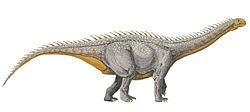| Cetiosauridae | |
|---|---|
 | |
| Restoration of Cetiosaurus | |
| Scientific classification | |
| Domain: | Eukaryota |
| Kingdom: | Animalia |
| Phylum: | Chordata |
| Clade: | Dinosauria |
| Clade: | Saurischia |
| Clade: | † Sauropodomorpha |
| Clade: | † Sauropoda |
| Clade: | † Eusauropoda |
| Family: | † Cetiosauridae Lydekker, 1888 |
| Subgroups [1] | |
| |
Cetiosauridae is a family of sauropod dinosaurs which was first proposed by Richard Lydekker in 1888. [2] While traditionally a wastebasket taxon containing various unrelated species, some recent studies have found that it may represent a natural clade. [1] Alongside Cetiosaurus from the Middle Jurassic of Britain, other taxa recently assigned to the family include Lapparentosaurus from the Middle Jurassic of Madagascar, [3] and Patagosaurus from the late Early-Middle Jurassic of Patagonia, [4] which share autapomorphies with Cetiosaurus that are not shared by other eusauropods. Additionally, at least one study has suggested that the mamenchisaurids may represent a sub-group of the cetiosaurids, which would be termed Mamenchisaurinae. [1]
Cladogram of Sauropoda after Holwerda et al 2021, showing the position of Cetiosauridae: [4]
| Sauropoda |
| ||||||||||||||||||||||||||||||||||||











